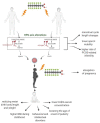Endocrine Disruptor Potential of Short- and Long-Chain Perfluoroalkyl Substances (PFASs)-A Synthesis of Current Knowledge with Proposal of Molecular Mechanism
- PMID: 33670069
- PMCID: PMC7926449
- DOI: 10.3390/ijms22042148
Endocrine Disruptor Potential of Short- and Long-Chain Perfluoroalkyl Substances (PFASs)-A Synthesis of Current Knowledge with Proposal of Molecular Mechanism
Abstract
Endocrine disruptors are a group of chemical compounds that, even in low concentrations, cause a hormonal imbalance in the body, contributing to the development of various harmful health disorders. Many industry compounds, due to their important commercial value and numerous applications, are produced on a global scale, while the mechanism of their endocrine action has not been fully understood. In recent years, per- and polyfluoroalkyl substances (PFASs) have gained the interest of major international health organizations, and thus more and more studies have been aimed to explain the toxicity of these compounds. PFASs were firstly synthesized in the 1950s and broadly used in the industry in the production of firefighting agents, cosmetics and herbicides. The numerous industrial applications of PFASs, combined with the exceptionally long half-life of these substances in the human body and extreme environmental persistence, result in a common and chronic exposure of the general population to their action. Available data have suggested that human exposure to PFASs can occur during different stages of development and may cause short- or/and long-term health effects. This paper synthetizes the current literature reports on the presence, bioaccumulation and, particularly, endocrine toxicity of selected long- and short-chain PFASs, with a special emphasis on the mechanisms underlying their endocrine actions.
Keywords: PFHxS; PFOA; PFOS; endocrine disruptor; perfluoroalkyl substances; prenatal exposure; short-chain PFASs.
Conflict of interest statement
The authors declare no conflict of interest.
Figures





Similar articles
-
Behavioural effects and bioconcentration of per- and polyfluoroalkyl substances (PFASs) in zebrafish (Danio rerio) embryos.Chemosphere. 2020 Apr;245:125573. doi: 10.1016/j.chemosphere.2019.125573. Epub 2019 Dec 7. Chemosphere. 2020. PMID: 31877453
-
Perfluoroalkyl substances cause Leydig cell dysfunction as endocrine disruptors.Chemosphere. 2020 Aug;253:126764. doi: 10.1016/j.chemosphere.2020.126764. Epub 2020 Apr 12. Chemosphere. 2020. PMID: 32464778 Review.
-
Association of Perfluoroalkyl and Polyfluoroalkyl Substances With Premature Ovarian Insufficiency in Chinese Women.J Clin Endocrinol Metab. 2018 Jul 1;103(7):2543-2551. doi: 10.1210/jc.2017-02783. J Clin Endocrinol Metab. 2018. PMID: 29986037
-
Determinants of prenatal exposure to perfluoroalkyl substances in the Slovak birth cohort.Environ Int. 2018 Dec;121(Pt 2):1304-1310. doi: 10.1016/j.envint.2018.10.051. Epub 2018 Nov 9. Environ Int. 2018. PMID: 30420127
-
Fate and effects of poly- and perfluoroalkyl substances in the aquatic environment: a review.Environ Toxicol Chem. 2014 Sep;33(9):1921-9. doi: 10.1002/etc.2663. Epub 2014 Jul 31. Environ Toxicol Chem. 2014. PMID: 24924660 Review.
Cited by
-
A Review of Per- and Polyfluorinated Alkyl Substance Impairment of Reproduction.Front Toxicol. 2021 Nov 22;3:732436. doi: 10.3389/ftox.2021.732436. eCollection 2021. Front Toxicol. 2021. PMID: 35295153 Free PMC article. Review.
-
Exposure to perfluoroalkyl and polyfluoroalkyl substances and pediatric obesity: a systematic review and meta-analysis.Int J Obes (Lond). 2024 Feb;48(2):131-146. doi: 10.1038/s41366-023-01401-6. Epub 2023 Oct 31. Int J Obes (Lond). 2024. PMID: 37907715 Free PMC article.
-
Molecular Alterations in Semen of Per-And Polyfluoroalkyl Substance Exposed Subjects: Association Between DNA Integrity, Antioxidant Capacity and Lipoperoxides.Antioxidants (Basel). 2025 Jun 27;14(7):792. doi: 10.3390/antiox14070792. Antioxidants (Basel). 2025. PMID: 40722896 Free PMC article.
-
PFAS in Nigeria: Identifying data gaps that hinder assessments of ecotoxicological and human health impacts.Heliyon. 2024 Apr 21;10(9):e29922. doi: 10.1016/j.heliyon.2024.e29922. eCollection 2024 May 15. Heliyon. 2024. PMID: 38694092 Free PMC article. Review.
-
Associations of Serum Perfluoroalkyl Substances and Placental Human Chorionic Gonadotropin in Early Pregnancy, Measured in the UPSIDE Study in Rochester, New York.Environ Health Perspect. 2024 Apr;132(4):47008. doi: 10.1289/EHP12950. Epub 2024 Apr 16. Environ Health Perspect. 2024. PMID: 38625811 Free PMC article.
References
-
- WHO (World Health Organization) Global Assessment of the State-of-the-Science of Endocrine Disruptors. WHO/PCS/EDC/02.2. International Programme on Chemical Safety. [(accessed on 6 November 2020)];2002 Available online: http://www.who.int/ipcs/publications/new_issues/endocrine_disruptors/en.
-
- OECD Toward a New Comprehensive Global Database of per and Polyfuoroalkyl Substances (PFASs): Summary on Updating the OECD 2007 List of per-and Polyfuoroalkyl Substances (PFASs) [(accessed on 1 October 2020)];2018 Available online: http://www.oecd.org/officialdocuments/publicdisplaydocumentpdf/?cote=ENV....
-
- US EPA Fact Sheet PFOA & PFOS Drinking Water Health Advisories. EPA 800-F-16-003. Drinking Water Health Advisories for PFOA and PFOS (epa.gov) [(accessed on 3 October 2020)];2016 Available online: https://www.epa.gov/sites/production/files/2016-06/documents/drinkingwat....
Publication types
MeSH terms
Substances
Grants and funding
LinkOut - more resources
Full Text Sources
Other Literature Sources

